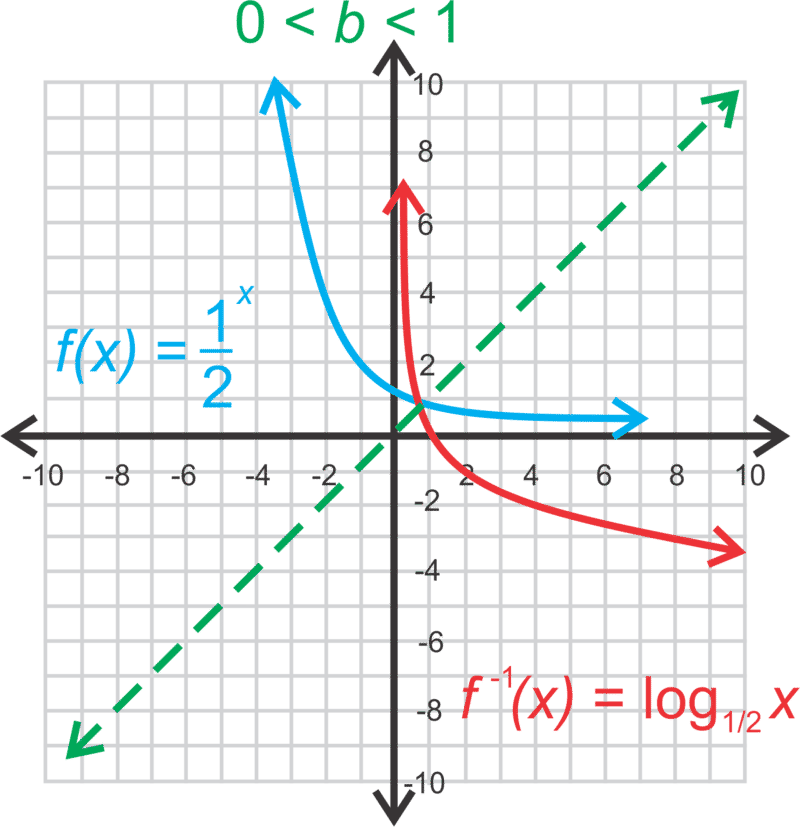8.7 图形对数函数
章节大纲
-
Your math homework assignment is to find out which quadrants the graph of the function falls in. On the way home, your best friend tells you, "This is the easiest homework assignment ever! All fall in Quadrants I and IV." You're not so sure, so you go home and graph the function as instructed. Your graph falls in Quadrant I as your friend thought, but instead of Quadrant IV, it also falls in Quadrants II and III. Which one of you is correct?
::您的数学作业任务是找出函数 f( x) = 4ln {( x+ 3) 的图形属于哪个四分位数。 在回家的路上, 您最好的朋友告诉你, “ 这是有史以来最简单的作业任务! 全部落在 Quadrants I 和 IV 中 。” 您不太确定, 因此您可以按指示回家, 绘制函数图。 您的图表在 Quadrant I 中依朋友的意想写在 Quadrant I 中, 而不是 Quadrant IV, 它也属于 Qadrant II 和 III 。 你们中的哪一个是正确的 ?Graphing Logarithmic Functions
::图形对数函数Now that we are more comfortable with using these functions as inverses, let’s use this idea to graph a logarithmic function. Recall that functions are inverses of each other when they are mirror images over the line . Therefore, if we reflect over , then we will get the graph of .
::现在,我们更愿意使用这些函数作为反函数,让我们使用这个想法来绘制对数函数。当函数是 y=x 线上的镜像图像时,提醒注意这些函数是彼此的反函数。因此,如果我们在 y=x 上反射 y=bx,那么我们就会得到 y=logbx 的图。Recall that an exponential function has a horizontal asymptote. Because the logarithm is its inverse, it will have a vertical asymptote. The general form of a logarithmic function is and the vertical asymptote is . The domain is and the range is all real numbers. Lastly, if , the graph moves up to the right. If , the graph moves down to the right.
::提醒注意一个指数函数有一个水平的单点。 由于对数是它的反向, 它将有一个垂直的单点。 对数函数的一般形式是 f( x) =alogb( x-h)+k, 垂直的对数函数一般形式是 x=h。 域是 x>h, 范围是全部真实数字。 最后, 如果 b>1, 图形会向右移动。 如果 0 < b < 1, 图形会向右移动 。Let's graph and state the domain and range.
::让我们用图y=log3}(x- 4)来说明域和范围。To graph a logarithmic function without a calculator, start by drawing the vertical asymptote, at . We know the graph is going to have the general shape of the first function above. Plot a few points, such as (5, 0), (7, 1), and (13, 2) and connect.
::要绘制一个没有计算器的对数函数,首先在 x=4 处绘制垂直静态。 我们知道该图将具有上面第一个函数的一般形状。 绘制几个点, 如 (5, 0, 7, 1) 和 (13, 2) , 并连接 。The domain is and the range is all real numbers.
::域为 x>4, 范围为所有实际数字 。Now, let's determine if (16, 1) is on .
::现在,让我们确定是否在y=log(x-6)上(16,1)。Plug in the point to the equation to see if it holds true.
::插在方程的点上 看看它是否真实。
::1=log(16-6)1=log101=1Yes, this is true, so (16, 1) is on the graph.
::是的,这是真的,所以图上是16,1。Finally, let's graph .
::最后,让我们用图表f(x)=2ln(x+1)To graph a natural log, we can use a graphing calculator. Press and enter in the function, , GRAPH .
::要绘制自然日志图, 我们可以使用图形计算器。 按 Y = 并输入此函数, Y= 2ln( x+1), GRAPH 。Examples
::实例Example 1
::例1Earlier, you were asked to determine if your friend was correct.
::早些时候,有人要求你确定你的朋友是否正确。The vertical asymptote of the function is . Since x will approach but never quite reach it, x can assume some negative values. Hence, the function will fall in Quadrants II and III. Therefore, you are correct and your friend is wrong.
::函数 f( x) = 4ln( x+3) 的垂直位数为 x @ 3。 由于 x 将接近 - 3, 但无法到达它, x 可以假定一些负值。 因此, 该函数将降为二次和三次。 因此, 您是正确的, 您的朋友错了 。Example 2
::例2Graph in an appropriate window.
::图y=log14x+2 在适当的窗口中。First, there is a vertical asymptote at . Now, determine a few easy points, points where the log is easy to find; such as (1, 2), (4, 1), (8, 0.5), and (16, 0).
::首先, x=0 时有一个垂直断点。 现在, 确定几个简单点, 日志容易找到的点 。 例如 (1, 2, 4, 1), (8, 0. 5) 和 (16, 0) 。To graph a logarithmic function using a TI-83/84, enter the function into and use the Formula: . The keystrokes would be:
::要用 TI-83/84 绘制对数函数,请将函数输入 Y= ,并使用 公式: logbxlogba : logax= logblogba。 键对数将是:, GRAPH
::Y=log(x)log(14)+2,GRAPHTo see a table of values, press GRAPH .
::要查看数值表,请按2ndGRAPH。Example 3
::例3Graph using a graphing calculator. Find the domain and range.
::使用图形计算器的 ylogx 图形。 查找域和范围 。The keystrokes are , GRAPH .
::键盘是Ylog(x),GRAPH。The domain is and the range is all real numbers.
::域为 x>0, 区域为所有实际数字 。Example 4
::例4Is (-2, 1) on the graph of ?
::f( x) =log12 ( x+4) 的图形是否( 2, 1) ?Plug (-2, 1) into to see if the equation holds true.
::插件 (-2, 1) 插入 f( x) = log12 ( x+ 4) , 看看方程式是否正确 。
::1=log12(-2+4)1=log12211Therefore, (-2, 1) is not on the graph. However, (-2, -1) is.
::因此,(-2,1)没有出现在图表中,但(-2,1)没有出现在图表中。Review
::回顾Graph the following logarithmic functions without using a calculator. State the equation of the asymptote, the domain and the range of each function.
::如下的对数函数图解,不使用计算器。请说明无线方程式的方程、域和每个函数的范围。-
::y=log5x -
::y=log2( x+1) -
::y=log(x)- 4 -
::y=log13(x- 1)+3 -
::ylog12( x+3) - 5 -
::y=log4( 2- x)+2
Graph the following logarithmic functions using your graphing calculator.
::用您的图形计算计算器绘制对数函数之后的对数函数。-
::y=ln( x+6)- 1 -
::yln(x- 1)+2 -
::y=log( 1- x)+3 -
::y=log( x+2) - 4 -
How would you graph
on the graphing calculator? Graph the function.
::您如何在图形化计算器上绘制 y=log4x 的图形? 图形化函数 。 -
Graph
on the graphing calculator.
::图解计算器上的 y=log34x。 -
Is (3, 8) on the graph of
?
::y=log3&(2x-3)+7的图中是否(3,8)? -
Is (9, -2) on the graph of
?
::y=log14(x-5)的图表上是否(9,2)? -
Is (4, 5) on the graph of
?
::y=5log2(8-x)的图上是否有(4,5)?
Review (Answers)
::回顾(答复)Click to see the answer key or go to the Table of Contents and click on the Answer Key under the 'Other Versions' option.
::单击可查看答题键, 或转到目录中, 单击“ 其他版本” 选项下的答题键 。 -





